SUBJECTS
GRADE
Show Results
Viewing Water as a Gift
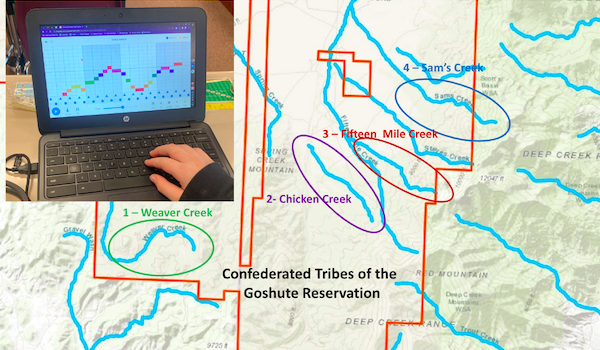
Lesson Summary
- Create melodies based on contour lines
- Learn how water plays an important role for the Confederated Tribes of the Goshute Reservation
- Explore how humans can balance everyday needs while conserving water
Lesson Plan and Procedure
Lesson Key Facts
- Grade(s): K, 1, 2, 3, 4, 5, 6, 7, 8, 9, 10, 11, 12
- Subject(s): Music, Science, Social Studies, Native American, Tribe Approved
- Duration of lesson: 4 sessions, 30-45 minutes each
- Author(s): Charlene Pete, Clell Pete, and Emily Soderborg

The Confederated Tribes of the Goshute Reservation’s Business Council selected this lesson content in answer to the question, “What would you like the students of Utah to know about you?” Charlene Pete, the CTGR Educator Director, and Clell Pete, the 2022 Business Council Vice Chair, represented the Confederated Tribes of the Goshute in crafting the lesson to provide expertise, accuracy, and authenticity. The lesson received approval for publication with the tribal seal by the 2023 CTGR Business Council, whose headquarters are in Ibapah, Utah.
Before teaching this lesson, please explain to your students that while there are many Native tribes in the United States, this lesson specifically focuses on experiences of the Confederated Tribes of the Goshute and does not represent other Indigenous groups, unless specifically identified.
Session One: Water Ups and Downs
Teacher: Today we are going to talk about water. What are some ways you use water?
Turn to a partner and tell them something you use water for.
Show this infographic to help students process the information that will be shared.
Teacher: Water is one of our most important natural resources. All life on Earth depends on water. Natural resources—such as water, air, plants, wildlife, soil, and fossil fuels—are used by humans for the basic necessities of life, including food, drinking water, energy, and shelter. Humans need water because our bodies are at least 60% water. We can survive a month without food, but only a week without drinking water. Throughout history, access to freshwater has determined where civilizations began and thrived. How much of Earth do you think is covered by water?
Show both a globe and a flat map, and if necessary, point out where the water is.
Teacher: About 71 percent of the Earth's surface is covered by water. So, if ten people in our class represented the world, seven would be the water and only three would be the land. The oceans hold about 96.5 percent of all of Earth's water. Can we drink ocean water? No! The water in the ocean is too salty for us. We need freshwater to survive. Freshwater is found on Earth’s surface in lakes, rivers, and ice, as well as below the surface as groundwater. Freshwater is a limited resource; it makes up only about three percent of all water on Earth. Of this 3%, 2.5% of it is unavailable because it is frozen as snow and ice, locked up in the atmosphere and soil, polluted, or lies too far under the earth’s surface to be extracted at a reasonable cost. That means only 0.5% of all the earth’s fresh water is easily accessible as surface water in rivers, streams and lakes.
Teacher: Do you know how water gets to us? How does water move? Water flows. We’re going to use that idea to inspire us as we create water melodies. A melody is a series, or a flow, of musical notes that are memorable and sound like they belong together. Our melodies are going to flow like water. In addition, we are going to use actual water pathways to guide us.
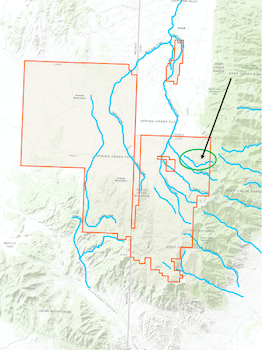
Show the map from the Confederated Tribes of the Goshute Reservation, without saying what location this map is showing.
Teacher: What can you tell me about this picture? What do you see?
Allows students to share their observations. If necessary, identify this as a map.
Teacher: How can you tell where the water is? Where the mountains are?
Note: The water on this map actually flows from right to left, but because we are also focusing on helping students read, we will move from left to right on the map.
Teacher: Using the contour of the water on this map, we will create our melodies. Let me show you. Look at this top stream. Look at its contour, which means the shape of the line starting on the left and moving to the right. It starts high, so my melody is going to start high. This stream then flows down, has one tiny part go up, then goes back down some more, so my melody will do the same. It goes straight across for a little bit then down some more before flowing back up. Again, it has a few notes straight across, then continues up, and finishes by turning down just a little bit.
Teacher: Let’s practice showing melodic contour with our bodies. When you hear a high note, stand. When you hear a note in the middle, squat half-way down. If you hear a low note, bend to the ground or sit down.
Play or sing some notes to assess student understanding of melodic contour (sung, played on a recorder, using Chrome music lab, or another way of playing a high sound).
Teacher: Now that we have practiced melodic contour with our bodies, listen to one possible melody that follows the contour of this stream, and show the highs and lows with your bodies as you listen.
Model creating your own melody following the contour. You could do this by singing, creating a melody on a barred instrument or tone bells, or using Chrome Music Lab or a virtual xylophone.
If you would feel more comfortable sharing a previously created melody, here are two options:
• Chrome Music Lab Melody
• Audio recording of singing
Teacher: Follow along, this time drawing the contour with your finger in the air as you listen to the melody again.
Sing or play the same melody again. It is important for students to understand that composing a melody means being able to repeat what was created, rather than coming up with something new each time. Coming up with something new each time is called improvising rather than composing.

Teacher: Do any of you think you could sing the melody for this water contour with me? If you feel comfortable, feel free to sing with me. If you don’t feel like you know the melody yet, you can continue tracing the contour in the air with your finger as you listen. Listening is important. It gives our brains time to remember what is being heard.
Have willing students sing the melody with you, while all draw the contour in the air.
Teacher: Now it is your turn to create a water melody that uses one of the other water contours shown on our map. Click the slide presentation to have the other water contours highlighted, named, and numbered. Did you notice that a melody only has one note at a time, without any notes trying to sound on top of each other? As you compose today, remember to keep your melody only sounding one note at a time, so you can sing it. Your melody should be singable, simple, and short. Once you have created a melody, practice it several times, so you can remember it. A composition is something that can be repeated, so to compose we have to remember what we created. Practicing will help you prepare to perform your melody for the class. As each of you performs, classmates will listen to the performance and try to determine which contour you chose for your melody.
Note: It is important to remember that for first-time attempts, there are no right or wrong notes—it is about simply introducing the idea of contour and seeing whether students understand the concept by being able to put together a series of notes to match a visual contour.
Spend five minutes having students create their water contour melodies.
If there is time, have each student perform for the entire class. If time is limited, have students perform for small groups.
Session 2: Confederated Tribes of the Goshute Reservation
Teacher: Help me remember what it was that we were looking at to create our melodies. A map! What location do you think this map is showing? This map is of the Confederated Tribes of the Goshute Reservation, found on the western edge of Utah and eastern edge of Nevada.
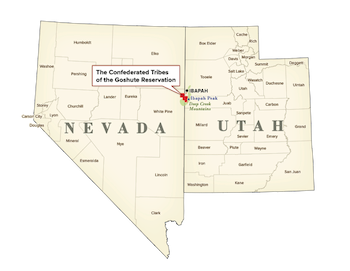
Show map of the Confederated Tribes of the Goshute Reservation within the Utah and Nevada state borders.
Teacher: The Confederated Tribes of the Goshute reservation is located southeast of Wendover near the Deep Creek Mountains. There are about 600 members of the tribal nation. In the United States, there are over 570 different federally recognized Native American Nations.
Show map from https://native-land.ca/
Teacher: This map shows tribal groups, so there are even more distinct Native American nations than what we are seeing here. The Confederated Tribes of the Goshute Reservation (CTGR) is one of eight federally recognized tribes in Utah. To be a federally recognized tribe means they have a government-to-government relationship with the United States. The tribe has certain rights to self-government.
Show the eight federally recognized tribal nations found within Utah.
Teacher: The Confederated Tribes of the Goshute reservation measures about 525 square miles and is located in Juab and Tooele Counties in Utah as well as White Pine County in Nevada. To put this in perspective, Utah County measures 2,144 square miles, and the southern populated half of Utah County from Provo to Santaquin is about 475 square miles. Does that help you picture about how large the Confederated Tribes of the Goshute reservation is?
Teacher: The Goshute people say they have been in the Great Basin area since time immemorial, which means they have been here forever. Through the centuries the Goshute developed a culture that adapted and thrived in the desert. They constructed wickiups or brush shelters; gathered seasonal seeds, pine nuts, grasses, and roots; collected insects, larvae, and small reptiles; and hunted antelope, deer, rabbit and other small mammals. They stored nuts and dried meats to survive the winter months. Because they live in the desert, access to water has always been extremely important.
Show current images of Ibapah.
Teacher: Ibapah, known in the Goshute language as Aipimpa, is a secluded ranching community and Indian reservation tucked away into the western desert of Tooele County, Utah. Many years ago, early Goshute Indians used the word “Aipimpa” to describe the chalky creek that winds through the valley. The water was essential for survival to the early inhabitants, and it remains so today. The Goshute water supply has been and continues to be threatened by different entities wishing to tap into the ground water aquifers of the area with the hope of piping it to other locations with populations that use more water than is currently available in their own area. The efforts to stop this from happening are ongoing, but even still, this precious resource remains in jeopardy.
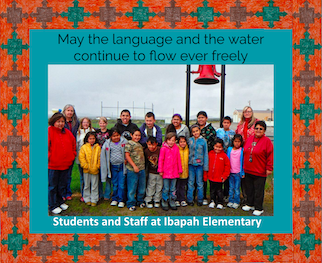
Teacher: In 2006, the Goshutes began a lengthy fight for their water rights that continues today. The value of water to the CTGR is understood by even the youngest members of their community. Leaders of the CTGR are concerned that efforts to pump groundwater from a series of valleys south of their reservation will drain their desert springs. They rely on spring water, regional streams, and access to irrigation water. The Goshute also know that if water is piped to other locations, it leaves the plants and animals in the original area without water. The water pipeline battle is a fight for the Goshute to preserve their water rights and what’s left of their traditional life. To the Goshute, the threat of lost water is more than just for people, plants, and animals—water carries a soul. Rupert Steele, a past tribal chairman, shared, "We know our ancestors for a long time left their spirits here." The Goshutes hold ceremonies at the water springs, and some come to drink from and "talk to the water" when ill. "If this dries up," Steele warned, "that goes away. We have no place to practice our spiritual ways." https://archive.sltrib.com/article.php?id=51665514&itype=CMSID#gallery-carousel-446996
Water Changes
Teacher: Let’s look at our water contour melodies. How would your melody change if the water were routed somewhere else? How would your water contour line change based on how you changed the melody?
Sing or play the melody with the beginning starting the same as the first melody shared, but after the first few notes, change the melody to show the water traveling somewhere else. If desired, have students listen to a Chrome music lab adaptation to the first Chrome music lab melody, rather than creating a new melody.
Teacher: Help me double check my composition. Was my melody still singable? Simple? Short?
Have students give thumbs up or down.
Teacher: Now I need to figure out how to show that change in my contour. I need to write it down, so I don’t forget what I did. Composers write down the music they create.
Start drawing your original contour on board where students can see, but then change the contour to have the water show it went somewhere different. If desired, you can first give a non-example here to help them understand what not to do, by creating something that doesn’t match the melodic contour you just created.
Teacher: Did it match how I redirected the melody? What do I need to do differently?
Sing or play the new melody and have students check that it matches the contour.
Teacher: Each of you will compose a new water contour melody. Your melody should start the same as your first water melody. After the first few notes, make changes in your melody to show how the water is being routed somewhere else. Keep it singable, simple, and short. Once you have figured out your new melody, draw a water contour line that represents the new melody. Ask yourself, “if someone heard my melody and saw the contour, would they be able to match the two?”
Note: You might need to help students understand that their contour line needs to move from left to right across their paper. If students try to have the contour line go back to the left, or loop around in circles, it would be showing more than one note sounding at the same time.
Give students time to compose new melodies and then draw their melodic contours.
Viewing Water as a Gift
Teacher: The Goshute people have worked hard to have their water stay in their valleys. They feel the water is sacred, and they must protect it. To them, water is a precious gift. This is a page from the book Aipimpa, written by the students and teachers at Ibapah Elementary.
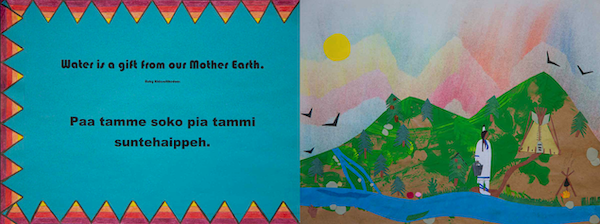
Have students listen to Clell Pete say the phrase “Our water—our Mother Earth gift” in the Goshute language.
Tamme-paa, tamme-sogopiatheea oo-toop
Our water—our Mother Earth gift
Help students say this entire phrase, or at least say paa, understanding that paa = water.
Session 3: Water Protectors
Review the Goshute phrase with the students.
Teacher: The Goshute people know that we wouldn’t be here if it wasn’t for water. It gives life to everything—the plants, mountains, trees, animals—not just the Newe people. Water brings things together. It brings the animals, and they instinctively know where to dig for water in the desert. Water brings people together. Before reservations were established, every year in Spring Valley, known to the Goshute as Basawabee, the people would meet for celebrations. It was a meeting place for many related peoples, not just the Goshute, but also the Shoshone, Paiute, Pahvant, and others traveling through. For the Goshute, water is life because water carries the songs and connects people today to their ancestors who came before. Rupert Steele, CTGR Chairman, has said, “I always sing songs for my people. When a relative passes away, their remains go back to Mother Earth … those songs will come up in the water. That’s why water is life.”
Teacher: There are other Indigenous cultures that also believe that “water is life.” They believe that water is an elder and a respected teacher. We must learn to listen to the water. We’re going to read the 2021 Caldecott winner book, called We Are Water Protectors. The author, Carole Lindstrom is Anishinaabe/Métis and is tribally enrolled with the Turtle Mountain Band of Ojibwe.
Show Native lands map again, and quickly discuss how this is a different tribal nation, with a different culture and language.
Teacher: Ms. Lindstrom shares in this book what her people believe about water. Listen and see if you can hear similarities and differences with the Goshute beliefs.
Read through We Are Water Protectors.
Have a discussion with students about the book.
Connecting with Science and Engineering Standards
Teacher: The reason people try to move water from one area to another area, is because water is needed by every living thing to survive. Today, in small groups, we are going to design and communicate a solution to address the effects that humans experience while trying to survive in their surroundings. Utah is a desert, which means there is limited amount of water. If people take water from one place, the living things in the location the water was taken from no longer have access to all the water they previously had.
For younger students, lead them through a water conservation SEEd experience where they ask questions, gather information, and convey designs for ways a child and his family can save water. An optional extension would be to have students take home a blank daily water usage tally sheet to fill out with their families, and then show designs for how their own families can save water.
Teacher: Conserving water doesn’t have to be hard. It means making small changes in the way you do things. After you get used to the changes, you might like to make more changes in your life to conserve even more water. Pretty soon, you could be conserving water just for the pleasure of knowing that you’re helping the environment. That’s when you’ll become a good “steward” of the Earth. From what we learned, what are some things humans can do to care for the earth and protect our natural resources, while still meeting our needs? How can we be good stewards of Utah’s water, using only the water we need or finding ways to reuse water? What solution(s) can you think of to help protect our water?
Some examples students might come up with could include the following:
- Turn the water off when you brush your teeth;
- Take shorter showers;
- Wear clothes more than once if the clothes are not dirty;
- Use the leftover water from boiling pasta to water plants;
- Plant your yard with native plants that don’t require as much water;
- Set your lawn mower to mow higher, so the grass doesn’t grow as quickly.
Additional ideas can be found at these links:
For older students, have them evaluate design solutions for conserving Earth’s environments and resources through a water conservation SEEd experience. The students will define the problem, identify criteria and constraints, analyze available data on proposed solutions, and determine an optimal solution. This SEEd experience emphasizes how humans can balance everyday needs while conserving Earth’s environments and resources.
Session 4: Music Inspired by Water Conservation
Teacher: Now that you have decided on one solution to help conserve water, you will create a third melody, inspired by the solution you designed. Remember a melody is a series of musical notes that are memorable and sound like they belong together. This third melody should again be singable, simple, and short. However, it does not need to have anything the same as the other two melodies you created today, except the same ending note. It should represent how you can take care of Earth’s natural resources. Once you have created a melody, practice it several times, so you can remember it, then draw a contour line that represents the new melody.
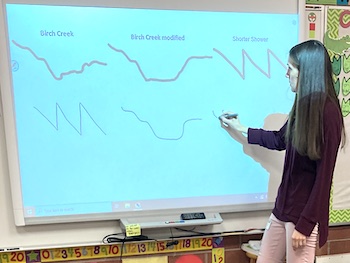
Give students a few minutes to create a new melody.
Teacher: You have now created three short water melodies. Each person will create an entire song with a beginning, middle, and end by putting the three melodies together in an order you think sounds good. You might choose to have each melody play once, or you may choose to repeat a melody more than once. After deciding how the melodies will be arranged, draw your contour lines in the correct order to notate, or show, how your entire song will be put together.
Have students perform their songs for the class or small groups, depending on time availability. You could also take a few minutes throughout the day or across several days to have students perform, instead of having students perform in one large block of time.
Water Songs
Teacher: We have created a song today that represents water and taking care of water. The Goshute people have songs they sing to their water. The water listens as they sing. The people listen and learn from the water. However, because water is so important to them, these Goshute songs are sacred. Because of their sacredness, they are not appropriate to be shared in the classroom. Many people across the world respect and honor water, so there are many water songs from many different cultures—each with its own deep meaning and beauty. The Algonquin people, an indigenous nation located near the Great Lakes in the United States and Canada, created a water song that can be sung by those who want to honor and protect the water. This specific water song was composed by Irene Wawatie Jerome, an Anishinaabe/Cree, with the purpose of providing a song with lyrics that are easy to learn, so the song could be shared with others. The Algonquin people want this song taught to others, so water all over the world can be sung to, healed, and protected. In 2017, an honored Grandmother who originally sang this water song met again with Algonquin Elders in Canada about this song, and together they decided that a video of the song should be made to hasten the teaching and widen the circle of women singing it because of the increasingly grave dangers our waters are facing. The families of the original composer and singers gave permission to record the song on this video. (This paragraph is summarized from https://www.singthewatersong.com/history-of-the-water-song)
Teacher: Today we will listen respectfully to the Algonquin Water Song.
Teacher: What did you notice as you listened to and watched this water song? How would you describe feelings conveyed by the music? How does the song compare and/or contrast with the water melodies you wrote today?
Have a discussion with students about their own connection and awareness of the water they interact with daily even in the shower or at the sink. Becoming aware of our natural resources is the first step to helping all living things have the resources needed to survive.
Remind students of the statements “Our Water–Our Mother Earth Gift,” “Water is a gift from Mother Earth,” and “Water is Life.” Have students create their own personal statement about the importance of water in their lives.
Learning Objectives
- Understand more about the Confederated Tribes of the Goshute Reservation.
- Compose melodies.
- Notate melodies with iconic notation (contour lines).
- Describe feelings conveyed by a music selection.
- Relate music to personal and social experience.
- Design solutions or evaluate design solutions whose primary function is to conserve Earth’s environments and resources.
- Distinguish between land and water on maps and globes.
- Identify leaders of social and political movements.
Utah State Board of Education Standards
This lesson can be used to meet standards in many grades and subject areas. We will highlight standards from a lower grade and an upper grade to give an example of application.
Grade K Music
Standard K.M.CR.3: Organize musical ideas using iconic notation or recordings.
Standard K.M.CR.1: Explore music concepts of steady beat, timbre, and melody
Standard K.M.R.2: Describe feelings conveyed by a music selection and identify elements in a music selection that elicit feelings.
Standard K.M.CO.2: Describe how music relates to personal and social experience.
Grade K Science with Engineering Education (SEEd)
Strand K.2: LIVING THINGS AND THEIR SURROUNDINGS
Living things (plants and animals, including humans) depend on their surroundings to get what they need, including food, water, shelter, and a favorable temperature. The characteristics of surroundings influence where living things are naturally found. Plants and animals affect and respond to their surroundings.
Standard K.2.1: Obtain, evaluate, and communicate information to describe patterns of what living things (plants and animals, including humans) need to survive. Emphasize the similarities and differences between the survival needs of all living things. Examples could include that plants depend on air, water, minerals, and light to survive, or animals depend on plants or other animals to survive. (LS1.C)
Standard K.2.2: Obtain, evaluate, and communicate information about patterns in the relationships between the needs of different living things (plants and animals, including humans) and the places they live. Emphasize that living things need water, air, and resources and that they live in places that have the things they need. Examples could include investigating plants grown in various locations and comparing the results or comparing animals with the places they live. (LS2.B, ESS3.A)
Standard K.2.3: Obtain, evaluate, and communicate information about how living things (plants and animals, including humans) affect their surroundings to survive. Examples could include squirrels digging in the ground to hide their food, plant roots breaking concrete, or humans building shelters. (ESS2.E)
Standard K.2.4: Design and communicate a solution to address the effects that living things (plants and animals, including humans) experience while trying to survive in their surroundings. Define the problem by asking questions and gathering information, convey designs through sketches, drawings, or physical models, and compare designs. Emphasize students working from a plant, animal, or human perspective. Examples could include a plant growing to get more sunlight, a beaver building a dam, or humans caring for the Earth by reusing and recycling natural resources. (ESS3.C, ETS1.A, ETS1.B, ETS1.C)
Grade K Social Studies
Standard K.3.2: List and describe the essential qualities needed to learn and work together as friends, neighbors, and family members (for example, honesty, integrity, morality, civility, duty, honor, service, respect, obedience to law).
Standard K.2.1: Construct a simple map, and explain how the map represents a place.
Standard K.2.2: Explain how a globe is a model of the Earth.
Standard K.2.3: Recognize and describe geographical features in their community that make it unique (for example, mountains, rivers, lakes, roads).
Standard K.2.4: Describe and use relative location terms of objects (for example, left/right, above/below, up/down, near/far) while using maps and globes.
Grade 5 Music
Standard 5.M.CR.4: Select and demonstrate developed musical ideas for improvisations, arrangements, or compositions, and explain intent and connection to purpose and context.
Standard 5.M.CR.5: Organize personal musical ideas using iconic notation or recordings to combine and/or sequence personal rhythmic, melodic and harmonic ideas.
Standard 5.M.R.4: Describe feelings or imagery conveyed by a music selection.
Standard 5.M.R.8: Describe, verbally or in writing, the reason for selecting certain music to listen to or perform, including reference to music elements, skills, purpose, cultural, or historical connections.
Standard 5.M.CO.2: Draw upon interests, knowledge, and skills developed to inspire and inform the creating, performance, and appreciation of music.
Standard 5.M.CO.3: Deepen understanding of another content area through music.
Standard 5.M.CO.4: Experience and explore music which connects us to history, culture, heritage, and community.
Grade 5 Science with Engineering Education (SEEd)
Standard 5.1.2: Use mathematics and computational thinking to compare the quantity of saltwater and freshwater in various reservoirs to provide evidence for the distribution of water on Earth. Emphasize reservoirs such as oceans, lakes, rivers, glaciers, groundwater, and polar ice caps. Examples of using mathematics and computational thinking could include measuring, estimating, graphing, or finding percentages of quantities. (ESS2.C)
Standard 5.3.4: Evaluate design solutions whose primary function is to conserve Earth’s environments and resources. Define the problem, identify criteria and constraints, analyze available data on proposed solutions, and determine an optimal solution. Emphasize how humans can balance everyday needs (agriculture, industry, and energy) while conserving Earth’s environments and resources. (ESS3.A, ESS3.C, ETS1.A, ETS1.B, ETS1.C)
Grade 5 Social Studies
Standard K.2.2: Explain how a globe is a model of the Earth. Standard K.2.3: Recognize and describe geographical features in their community that make it unique (for example, mountains, rivers, lakes, roads).
Standard K.2.4: Describe and use relative location terms of objects (for example, left/right, above/below, up/down, near/far) while using maps and globes.
Standard K.3.3: Identify ways that people work together to build a strong community (for example, parents, religious leaders, teachers and other school personnel, police officers, firefighters, soldiers, business owners).
Standard 5.6.2: Evaluate the methods and impact of individuals and/or groups making positive changes in the United States today as models for civic engagement.
Standard 5.6.2: Evaluate the methods and impact of individuals and/or groups making positive changes in the United States today as models for civic engagement.
Equipment and Materials Needed
- Slide presentation with graphics—lower grades
- Slide presentation with graphics—upper grades
- NASA infographic on water found on their website: How Much Water Is on Earth?
- Map of the Confederated Tribes of the Goshute Reservation
- Map of the Confederated Tribes of the Goshute Reservation with water ways highlighted, named, and numbered
- Map of the Confederated Tribes of the Goshute Reservation within the Utah and Nevada state borders
- Map from https://native-land.ca/
- Globe or map of the world
- One melodic instrument for each student
- Singing voice
- Barred instrument such as a xylophone or glockenspiel
- Tone bells
- Chrome Music Lab
- Virtual xylophone
- Composed melody (optional)
- Composed adaptation of the first melody (optional)
- Audio recording of Clell Pete saying the phrase “Our water—our Mother Earth gift”
- Lindstrom, Carole, and Michaela Goade. We Are Water Protectors. Westport, CT: Weston Woods Studios, Inc., 2021.
- Water Conservation SEEd Experience
- Student Water Conservation SEEd experience (lower grades)
- Teacher Water Conservation SEEd experience key (lower grades)
- Student Water Conservation SEEd experience (upper grades)
- Teacher Water Conservation SEEd experience key (upper grades)
- Daily water usage tally sheet (optional)
- Algonquin Water Song video
Additional Resources
This lesson was created thanks to a grant from the National Endowment for the Arts and the Utah Division of Arts & Museums.
- Confederated Tribes of the Goshute Reservation website
- https://www.rgj.com/story/news/2019/11/13/las-vegas-southern-nevada-water-pipeline-fight-shoshone-native-tribes-sacred-land/2524475001/
- https://www.leg.state.nv.us/App/NELIS/REL/80th2019/ExhibitDocument/OpenExhibitDocument?exhibitId=44760&fileDownloadName=0227ab30ab51_ster_comment.pdf
- https://archive.sltrib.com/article.php?id=51665514&itype=CMSID#gallery-carousel-446996
- The Water Walker by Joanne Robertson
- “The Water Song” (It shares a story of where this song comes from in the video description)
- https://slowtheflow.org/indoor-tips/
- https://slowtheflow.org/outdoor-tips/
- https://ecosystems.psu.edu/outreach/youth/sftrc/lesson-plans/water/k-5/conservation-2
- Water Conservation with the Water Lion
Image References
Image 1: Emily Soderborg
Image 2: Confederated Tribes of the Goshute Reservation (CTGR)
Image 3-4: Emily Soderborg
Image 5: Curtis Soderborg
Image 6: 2011 Ibapah Elementary Students, courtesy of CTGR
Image 7: Ruby Ridesatthedoor
Image 8: Chelsie Bergera
© Brigham Young University and Confederated Tribes of the Goshute Reservation

www.education.byu.edu/arts/lessons
 Download
Download